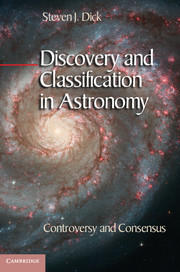Description
Discovery and Classification in Astronomy
Controversy and Consensus
Author: Dick Steven J.
This book shows that astronomical discovery is a complex and ongoing process comprising various stages of research, interpretation and understanding.
Language: English
Subject for Discovery and Classification in Astronomy:
Approximative price 57.55 €
In Print (Delivery period: 14 days).
Add to cart
Publication date: 09-2013
472 p. · 18.1x25.4 cm · Hardback
472 p. · 18.1x25.4 cm · Hardback
Description
/li>Contents
/li>Biography
/li>
Astronomical discovery involves more than detecting something previously unseen. The reclassification of Pluto as a dwarf planet in 2006, and the controversy it generated, shows that discovery is a complex and ongoing process ? one comprising various stages of research, interpretation and understanding. Ranging from Galileo's observation of Jupiter's satellites, Saturn's rings and star clusters, to Herschel's nebulae and the modern discovery of quasars and pulsars, Steven J. Dick's comprehensive history identifies the concept of 'extended discovery' as the engine of progress in astronomy. The text traces more than 400 years of telescopic observation, exploring how the signal discoveries of new astronomical objects relate to and inform one another, and why controversies such as Pluto's reclassification are commonplace in the field. The volume is complete with a detailed classification system for known classes of astronomical objects, offering students, researchers and amateur observers a valuable reference and guide.
Preface; Abbreviations; Introduction: the natural history of the heavens and the natural history of discovery; Part I. Entrée: 1. The Pluto affair; Part II. Narratives of Discovery: 2. Moons, rings, and asteroids: discovery in the realm of the planets; 3. In Herschel's gardens: nebulous discoveries in the realm of the stars; 4. Dwarfs, giants, and planets (again!): the discovery of the stars themselves; 5. Galaxies, quasars, and clusters: discovery in the realm of the galaxies; Part III. Patterns of Discovery: 6. The structure of discovery; 7. The varieties of discovery; 8. Discovery and classification; Part IV. Drivers of Discovery: 9. Technology and theory as drivers of discovery; Part V. The Synthesis of Discovery: 10. Luxuriant gardens and the master narrative; 11. The meaning of discovery; Appendix I; Appendix II.
Steven J. Dick served as the NASA Chief Historian from 2003 to 2009 and was the Charles A. Lindbergh Chair in Aerospace at the National Air and Space Museum from 2011 to 2012. He has worked as both an astronomer and historian of science. Minor planet 6544 Stevendick is named in his honor.
© 2024 LAVOISIER S.A.S.




